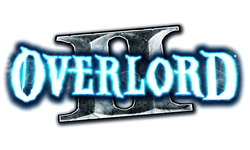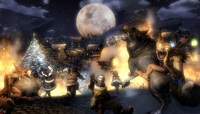|
|

|
PLATFORM
|
Xbox 360
|
BATTLE SYSTEM
|

|
INTERACTION
|

|
ORIGINALITY
|

|
STORY
|

|
MUSIC & SOUND
|

|
VISUALS
|

|
CHALLENGE
|
Moderate
|
COMPLETION TIME
|
20-40 Hours
|
|
OVERALL

|
+ Enslave or destroy, either way is a ton of fun.
+ Voicework is fantastic and hilarious.
+ Controls are intuitive and easy to learn...
- ...But can be cumbersome when trying to perform precision commands.
- Small, obnoxious sections of level design can hurt the overall experience.
- Awful save system.
|
Click here for scoring definitions
|
|
|
When Overlord quietly made its way onto store shelves two years ago, it was one of those games that you either played or never even heard about. A quirky fantasy tale where the player set out to conquer the world rather than save it, its Pikmin-like gameplay, terrific voicework, and twisted charm quickly gained it a cult following, enough so that publisher Codemasters deemed fit to bring not just one, but three new Overlord titles to light, all on the same day. The first and highest profile of these titles is Overlord II, a direct sequel to the original game.
Overlord II begins in the new Overlord's childhood, a young, evil tot tormenting the other children and wreaking havoc with magic and his newfound minion friends. The previous Overlord, it seems, accidentally got himself locked up in an infernal abyss, and the destruction-hungry minions have been without a master for quite some time. Without an evil ruler to spread fear and discontent across the land, a powerful human empire has risen up and declared war on the world of magical creatures. With the elves and empire busy fighting each other, it's your job as Overlord to set things right by conquering both these foolish factions and either wiping them out or putting them to work as your obedient slaves.
Much like the first game, the story merely acts as a backdrop for the inevitable murderous destruction, and doesn't really get particularly intriguing until the end. Those who've played the original Overlord will undoubtedly notice a few references to the events of the first game, but thankfully newcomers will have no trouble following the story as it unfolds. Overlord II also follows in its predecessor's footsteps by allowing the player to choose between being "evil" or "really evil." However, rather than choosing two fairly opposite paths as in the first game, Overlord II streamlines things a bit by simply making the player choose between domination and destruction, with the events continuing down pretty much the same path regardless of the choice made.
Although the choices feel less significant overall, they also adhere more to the principles of the game; you're pure, unadulterated evil and you're damn sure going to act like it. Whether that means murdering a city of innocents or enslaving them to do your bidding, their lives are going to suck from that point forward. The choices also play a more significant role in the actual gameplay, which is far and away the best new addition to the series.
As the player takes his Overlord down a path of destruction or domination, there are very obvious benefits and drawbacks to both. A path of destruction means more immediate rewards, providing copious amounts of the game's various resources right off the bat. However, once they've been consumed, they're gone for good. Enslaving a town, on the other hand, forces its people to work to create a steady stream of these resources constantly throughout the game's duration. While the initial return is fairly small, over time it can add up to a lot.
 The only thing worse than an elf is a hippie elf.
The only thing worse than an elf is a hippie elf.
|
|
Enslaving townspeople is probably one of the most enjoyable parts of Overlord II. The Overlord's evil presence is so powerful that he can use it to make them submit to his will, becoming subservient drones that diligently perform various tasks such as mining for gold, smithing weapons for the minion horde, or creating lifeforce to ensure a steady supply of actual minions.
The minion horde is key to Overlord II's gameplay. While the Overlord himself is a capable fighter in his own right, it's the minions that do the gruntwork. These adorably tyrannical little monsters come in four varieties, and can be commanded to fight enemies, move objects, and solve the various puzzles throughout the game. Many segments of combat are actually puzzles in disguise, as there are often extremely easy ways to win tough battles if a clever Overlord can figure them out.
In addition to commanding his minions, the Overlord himself has an arsenal of attacks at his disposal. A basic melee attack with a sword, axe, or mace is his simplest means of dishing out the delightful pain, but he is also capable of making use of his evil presence to cast various spells; three spells, to be exact, with two separate outcomes based on how they're cast. The simplest form of the Overlord's spell is a lightning beam that drains a foe's energy. When used on a peasant, the peasant can be enslaved if the spell is released once the pitiful wretch falls to his knees. Continuing will make his mind cave in, causing instant death. A second variation of the spell can be used to either power up the minion horde or unleash a powerful shockwave, while a third can power up a single minion or consume it to restore some of the Overlord's health. Depending on whether the player takes a path of domination or destruction, different aspects of each spell become stronger while the other becomes weaker.
Overlord II features a handful of new additions to the formula started two years ago. Red, Green, and Brown minions now have special mounts that they can acquire, each of which can be used to solve new styles of puzzles not seen in the previous game. The game also features some fairly epic siege sequences, wherein the Overlord and his minions control a catapult to destroy barricades, wipe out entire armies, and generally cause mayhem on a grand scale. If the player becomes attached to a particularly goofy looking minion, he can resurrect his dead buddy for a small fee. Finally, in certain sections of the game, the Overlord possesses a minion himself, allowing him to lead his horde into areas too small for his monstrous physique. These segments often play out similar to a stealth game, but a fair amount of brute force can be used as needed.
 Merry Christmas to all, now you're all gonna die!
Merry Christmas to all, now you're all gonna die!
|
|
In general, Overlord II provides a modest improvement over what was introduced in Overlord, but it also falls into some of the same pitfalls that plagued the first game. Although the camera controls have been greatly improved, allowing the player to rotate the camera manually with the right analog stick, it only provides horizontal movement — no vertical. This can make surveying the landscape awkward in certain areas, particularly if one is trying to plan a strategy for an upcoming battle. And like the first game, controls are terrific and intuitive for most purposes, but can be extremely cumbersome when trying to perform precision commands.
Some obnoxious level design also finds a way to hamper otherwise terrific sections of the game. For example, certain areas require the Overlord to taunt an enemy catapult into launching a boulder towards an impeding barricade. One misstep in these areas can cost your entire horde. There is also a section of the game involving spiders that is particularly frustrating; getting past it is a severe test of patience. Overlord II also has a terrible save system. Manual saves can only be performed at the tower, while automatic saves occur whenever an objective is met and occasionally when a new gateway back to the tower is reached. One of the most irritating aspects of this is that, if one should return to the tower before completing an objective, upon returning to the quest, all progress since the last automatic save will have to be repeated. If the player dies, he has to return to the last place the game saved, leading to further repeating of gameplay. It can become irritating mighty quickly.
Despite these issues, Overlord II is still loads of fun most of the time, and it's easy to become lost in the game's many intricacies: trying to find all the hidden objects, tracking down the one hundred occupants of each of the two enslavable towns, forging new equipment, decorating your tower, finding funny new hats for your minions, and even just enjoying some of the ridiculous voicework throughout the game. From hippie elves to groveling peasants, your ever-endearing minions to your trio of self-centered mistresses, there's always something amusing coming through the speakers. The audio quality doesn't end with the voicework. The soundtrack is equally endearing, particularly since certain songs feature the minions as vocalists!
Overlord II's visuals aren't anything to sneer at either. The art style is charming, the environments are lush, detailed, and generally destructible, and the fact that the game still manages to maintain a fairly stable frame rate (though it does dip occasionally) with as many as fifty minions and dozens of enemies on screen at once is as remarkable as ever.
The biggest detriment Overlord II faces is also one of its strongest points: it really doesn't take any major steps forward from the last game. But the original game was terrific, and there's enough that's new and enough that's been improved upon to make Overlord II as enjoyable as the first. The game isn't terribly long, likely lasting most players a bit more than twenty hours if they take their time, but there is room for a second playthrough if players want to try a different evil philosophy. Many RPGs offer players a choice between good and evil, but no series takes the same approach as Overlord. As Gnarl the Minion Master says, "It's good to be bad, but it's better to be evil."
Review Archives
|









